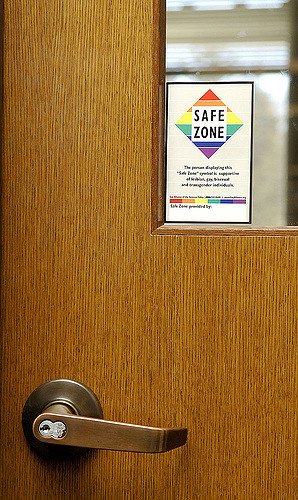According to Bell Hooks, “Feminism is not simply a struggle to end male chauvinism or a movement to ensure that women have equal rights with men; It is a commitment to eradicating the ideology of domination that permeates Western culture on various levels- sex, race, class, to name a few – and a commitment to reorganizing U.S. society so that the self- development of people can take precedence over imperialism, economic expansion and material desires” (quoted by Sandra Kim).
Even though it is traditionally about equality, there are always differing views about the LGBTQIA+ Community within different movements. In this piece, I’m going to go through different identities and discuss how the feminist movement has viewed them.
Lesbian:
There is a HUGE stereotype of all feminists being lesbians, and while this is certainly not true, lesbians did play a big part in the history of feminism. As Estelle Freedman wrote in her book No Turning Back: The History of Feminism and the Future of Women:
“Much of the women’s culture of the 1970s was largely lesbian culture…lesbians formed separate consciousness-raising groups and caucuses…lesbian feminists helped forge an influential concept of sexual identity” (88).
Additionally, however, looking at this stereotype, Anderson explains in the 2015 book, Modern Misogyny: Anti-Feminism in a Post Feminism Age that linking feminism to lesbians doesn’t make sense because they are a big target for gender inequality, especially in the way gender roles may be challenged. She says it “provides a disincentive for women to take collective action to challenge gender inequality” (128).
Gay Men:
Feminism is for everyone, not just women. Feminism is about gender and oppression and that includes everyone. While men are privileged in our society, gay men are in the minority. Interestingly enough, the way that gay men are sometimes feminine and compared to women can really make them understand the experiences women go through. As explained here, “Feminism showed me that critiquing or making jokes about gay men for certain feminine qualities was essentially critiquing women. It was a form of sexism that hurt more people than it made laugh” (Stafford). Feminism definitely helps gay men in the way that they are oppressed despite being privileged in our patriarchal society where men are above women.
Bisexual:
As I mentioned, many lesbians were involved in the feminist movement, which is where the stereotype comes from. Since many bisexual women are attracted to men as well as women, many people thought it went against the idea of challenging the system and the patriarchy.
As Hart explains, “The choice of woman loving allows lesbian feminists to envision and create an alternative world from the male supremacist hetero-relational one, based upon lesbian values, particularly an alternative lesbian sexuality” (quoted in Jeffreys).
Bisexuality also disrupted the visibility of lesbian feminists. Compared to other identities, lesbians (before more broad ones like queer and pansexual were coined) were the only ones who only loved women. While there is certainly a lot of biphobia and bierasure in today’s society, in history, bisexuals were reducing the theory behind lesbian feminism (Jeffreys).
Transgender:
If you’re reading this, you’ve probably heard about TERFS or trans-exclusionary radical feminists. Some of the views about trans women are:
- They are dangerous to cisgender women in public restrooms (Vasquez)
- They can’t relate to the same experiences (Serano)
- They enjoy male privilege (Finlayson)
- Trans people are not really women (Tosh)
- Trans women are would-be rapist (Jones)
Queer:
While we often use the word queer to refer to sexual orientation and genderqueer identities, it also refers to academia as queer theory. As Grant explains, “‘Queer’ theorists also advocate the disruption or destruction of traditional categories of sex and gender” (Jackson). I think we can see this concept applied in feminist circles. Now seen in classrooms and textbooks, feminism is often connected with queer politics, such as sexual expression, identity, and gender (Jackson).
Feminism is very connected with the representation of LGBTQ identities. While I know there are many identities, these are those in the standard acronym. I hope this teaches you a little about the history of them in connection to the feminist movement.
Sources:
Anderson, K.J. (2015). Modern Misogyny: Anti-Feminism in a Post-Feminist Era. New York, New York: Oxford University Press.
Finlayson, L. (2016). An Introduction to Feminism. Cambridge, England: Cambridge University Press.
Freedman, E.B. (2002). No Turning Back: The History of Feminism and the Future of Women. New York, New York: Penguin Random House.
Jackson, S. and Scott, S. (1996). Feminism and Sexuality: A Reader. New York, New York: Columbia University Press.
Jeffreys, S. (1999). Bisexual politics: A superior form of feminism?. Women’s Studies International Forum, 22(3), 273-285. doi:10.1016/S0277-5395(99)00020-5
Jones, K.B. (2016, Aug 02). Trans-Exclusionary Radical Feminism: What Exactly Is It, And Why Does It Hurt? The Huffington Post. Retrieved from: http://www.huffingtonpost.com/kelsie-brynn-jones/transexclusionary-radical-terf_b_5632332.html
Kim, S. (2012). Why Feminism is for Everybody. Everyday Feminism. Retrieved from: http://everydayfeminism.com/2012/07/feminism-is-for-everyone/
Stanfford, Z.(2013). How Feminism Made Me a Better Gay Man. Everyday Feminism. Retrieved from: http://everydayfeminism.com/2013/03/how-feminism-made-me-a-better-gay-man/
Tosh, J. (2016). Psychology and Gender Dysphoria: Feminist and Transgender Perspectives. New York, New York: Routledge.
VASQUEZ, T. (2016). IT’S TIME TO END THE LONG HISTORY OF FEMINISM FAILING TRANSGENDER WOMEN. Bitch Magazine: Feminist Response To Pop Culture, 15-19.






